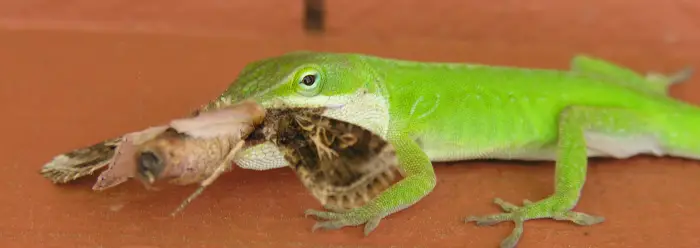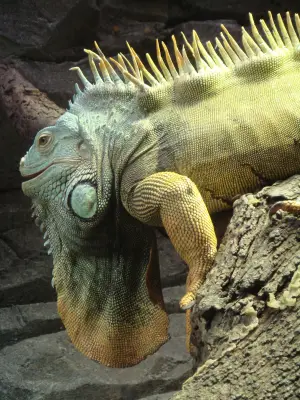Lizards are one of the biggest groups of reptiles with over 3800 recorded species. They can range from a few inches long to nearly ten feet and hundred of pounds. The sheer diversity of this suborder, from geckos to komodo dragons, makes it a bit hard to believe that all of these animals are, in fact, members of the same family.
However, all lizards have several traits in common, such as being cold-blooded, having overlapping scales and possessing acute vision. Many species of lizards are kept as pets and can make for friendly and long-lived companions.
Part of ensuring the longevity of your pet lizard is through proper nutrition. Lizards in captivity typically have very different diets than their wild counterparts, so it’s important to first understand what lizards eat in their natural environment, and how you can meet those same needs for your pet. If you would like to learn about lizard nutrition, or have found a lizard outside and don’t know what to feed it, the sections below will be able to help.
What do Wild Lizards Eat?
Table of Contents
Because there are so many types of lizards, there’s no standard lizard diet. Smaller lizards like chameleons, geckos and anoles eat mostly insects like flies and crickets. So, what do lizards eat besides flies and crickets? They also eat other small creatures like snails, spiders and caterpillars. The bigger the lizard, the bigger its prey.

The biggest lizard of them all, the komodo dragon, has special bacteria in its saliva that eventually paralyzes and kills its prey. The komodo dragon is a ferocious predator and has been known to hunt deer, pigs and even unlucky humans. Not all lizards are carnivores, however. Iguanas are exclusively herbivorous. They climb up into trees and eat the leaves, fruits and berries they find there. Since they live on every continent except Antarctica, the diet of each lizard species is highly specialized. This is why a good working knowledge of where your lizard is from and what it eats in the wild is so important.
What do Pet Lizards eat and drink?
Of course, no one expects you to make a weekly expedition into the Hawaiian jungles to feed your pet lizard. Some species are notoriously difficult to care for, but others are quite hardy and versatile. The majority of commonly kept lizards are insectivores and can be kept alive on an easy diet of crickets with a few supplements. Knowing what species your lizard is is a vital first step for ensuring its proper nutrition.
For example, bearded dragons are omnivorous. A good diet for a bearded dragon will include plenty of leafy greens as well as crickets and even mice. Geckos like to hunt down insects, but also love sweet fruits. One treat gecko owners have discovered is baby food made from fruits. Iguanas require a wide variety of vegetables, greens and fruits to have all of their nutritional needs met. This makes them one of the more difficult lizard species to keep. It’s important to remember that lizards love a good chase and will often reject food that is already dead. Live crickets and worms are sold in many pet stores for this reason.
What do baby Lizards Eat
If you have found what you believe to be a baby, or adult, lizard outside, you may want to save yourself some trouble and re-release it. If you are thinking about keeping it as a pet, or if it is below freezing outside, the lizard will need some special care to be kept alive. It’s most important that the lizard have access to a source of UV light and heat. Pet stores carry UV lamps and small containers, even a cheap set is better than nothing. You should also pick up some form of ground cover, a water dish and live crickets.
Baby lizards are born fully capable of eating an adult diet, so don’t worry about making special considerations for one. Set up the container so that the light is at one end. This will give the lizard a chance to sun itself at its preferred temperature without overheating. You may offer it some crickets, but odds are your new guest will be most interested in getting warm. Use this time to do some research and identify the species and its individual needs. You will eventually need to take it to the vet to be treated for possibly fatal parasites. With any luck, your new pet will make the transition to captivity just fine. After all, most of the lizards at pet stores are just a few generations away from their wild ancestors.
What do Iguanas eat?
Iguanas are large lizards known for their size and ability to swim. They are also one of the few lizard species to be entirely vegetarian, making them popular pets among reptile enthusiasts. In the wild, iguanas consume tropical plants and fruits, using their strong limbs and claws to climb up into the branches of trees.

They eat over 100 varieties of plants, including wild plums, orchids, figs, vines, mangoes, bananas, rosemary and tomatoes. There have been some reports of iguanas eating dead fish and insects like grasshoppers, but many enthusiasts believe that too much protein can harm an iguana.
Captive iguanas are fed many different fruits and vegetables to stay healthy. Besides the plants listed above, popular foods include leafy greens like spinach and kale; fruits like mangoes, strawberries and grapes; turnip, mustard and collard greens; squash; and occasionally even bread.
